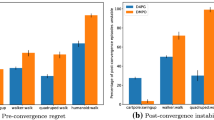Abstract
The proposed method is implemented in three steps: first, when a variation in environment is perceived, agents take appropriate actions. Second, the behaviors are stimulated and controlled through communication with other agents. Finally, the most frequently stimulated behavior is adopted as a group behavior strategy. In this paper, two different reward models, reward model 1 and reward model 2, are applied. Each reward model is designed to consider the reinforcement or constraint of behaviors. In competitive agent environments, the behavior considered to be advantageous is reinforced as adding reward values. On the contrary, the behavior considered to be disadvantageous is constrained by reducing the reward values. The validity of this strategy is verified through simulation.









Similar content being viewed by others
References
Nolfi S, Elman JL, Parisi D (1990) Learning and evolution in neural networks. CRL Technical Report 9019, University of California, San Diego
Gruau F, Whitley D (1993) Adding learning to the cellular development of neural networks: evolution and the Baldwin effect. Evol Comput I(3):213–233
Baldwin JM (1996) A new factor in evolution. In: Belew RK, Mitchell M (eds) Adaptive individuals in evolving populations: models and algorithms. Addison-Wesley, Reading
Collins RJ, Jefferson DR (1991) AntFarm: towards simulated evolution. In: Farmer JD, Langton C, Rasmussen S, Taylor C (eds) Artificial life II. Addison-Wesley, Reading
Collins RJ (1992) Studies in artificial evolution. PhD Thesis, Philosophy in Computer Science, University of California
Nolfi S, Floreano D (1998) Co-evolving predator and prey agents: dDo ‘arm races’ arise in artificial evolution? Artif Life 4(4):311–335
Victor R (1999) Lesser, cooperative multiagent systems: a personal view of the state of the art. IEEE Trans Knowl Data Eng 11(1):133–142
Marco Dorigo, Vittorio Maniezzo, Alberto Colorni (1996) Ant system: optimization by a colony of cooperating agents. IEEE Trans Syst Man Cybern B Cybern 26(1):29–41
Georgeff M (1999) A theory of action for multi-agent planning. In: Proceedings of the national conference on artificial intelligence, pp 121–125
David C Parkes, Lyle H Ungar (1997) Learning and adaptation in multiagent systems. In: AAAI workshop on multiagent learning providence
Kreifelt T, von Martial F (1991) A negotiation framework for autonomous agents. In: Demazeau Y, Muller JP (eds) Decentrilazed AI2. Elsevier, Amsterdam
Nwana HS, Lee L, Jennings NR (2001) Co-ordination in multi-agent systems. Software agents and soft computing, towards enhancing machine intelligence, concepts and applications. Springer, Berlin Heidelberg New York
Peter Stone, Manuela Veloso (2000) Multi-agent systems: a survey from a machine learning perspective. IEEE Trans Knowl Data Eng
Bae Han Kuk (2001) Evolution Strategy of agent using artificial life. Korea Inf Sci 27(4):142–162
Yasuo Nagayuki, Shin Ishii (1999) Multi-agent reinforcement learning: an approach based on the other agent’s internal model, from animals to animates. In: Proceedings of the 8th Conference on the simulation of adaptive behavior, MIT Press, Cambridge, pp 478–485
Kam-Chuen Jim, Lee Giles C (2000) Talkin Helps: evolving communicating agents for the predator–prey pursuit problem. Artif Life 6:237–254
Takayuki Kohri, Matsubayashi (2000) An adaptive architecture for modular Q-learning. In: Proceedings of the 10th international conference on simulation of adaptive behavior, MIT Press, Cambridge, pp 1–6
Collins Robert J, David R (1992) An artificial neural network representation for artificial organisms. In: Proceedings of the 1st workshop on parallel problem solving. Lecture Notes in Computer Science, Springer, Berlin Heidelberg New York, pp 496:259–263
Author information
Authors and Affiliations
Corresponding author
Rights and permissions
About this article
Cite this article
Lee, M.R., Kang, EK. Learning enabled cooperative agent behavior in an evolutionary and competitive environment. Neural Comput & Applic 15, 124–135 (2006). https://doi.org/10.1007/s00521-005-0020-z
Received:
Accepted:
Published:
Issue Date:
DOI: https://doi.org/10.1007/s00521-005-0020-z




